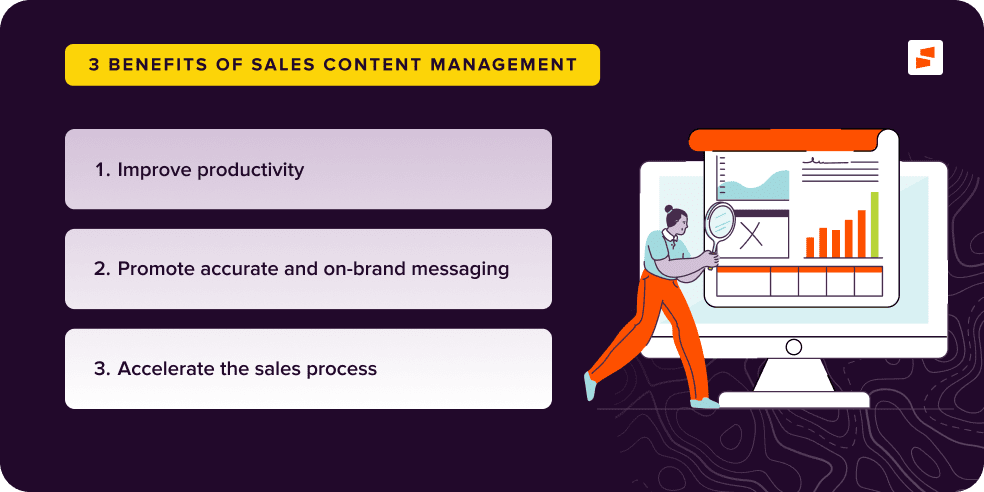Sifting through pitch decks, updating old one-pagers, and locating the most relevant white paper takes time for sellers. In fact, recent studies show that sales reps spend an average of 440 hours each year trying to find the right sales enablement content to share with prospects and customers. This ongoing search for the best content impacts seller productivity and puts reps at risk of stalling, and losing an important deal.
What is a sales content management strategy?
Because sales content is important, organizations need a well-designed sales content management strategy. Sales content management creates, organizes, stores, and shares sales collateral and content in one central location. This ensures sellers can easily find, personalize, and share relevant content with buyers at the right time.
The importance of sales content management
Sellers are working in a more competitive and ever-evolving sales landscape. Because of the transition to remote and hybrid workforces and changing buyer preferences, go-to-market teams need to embrace virtual selling to find new ways to connect with buyers and create meaningful relationships.
Buyers also research products and services, compare competitors, and look at customer reviews before they talk to a sales rep. So, when they finally engage with your sales team, they expect to receive useful information that answers their specific questions. The ability of sellers to address a buyer’s needs and deliver relevant sales and marketing content at the right time is one of the best ways to keep them informed and moving through the sales cycle.
Benefits of content management

Creating a single source of truth for your sales enablement resources is extremely valuable. Not only will it help sellers become more successful in their roles, it can also:
Improve productivity
On average, sellers spend 10 hours per week tracking down, comparing, or revising content. But when sellers know where to find sales collateral, they spend less time looking and more time focusing on their top priority: selling.
Promote accurate messaging and content usage
On average, 65% of content that’s created by marketing goes unused by sellers. Instead, reps spend time crafting content which increases the risk of delivering inaccurate information or inconsistent brand messaging. Sales content management increases the likelihood that marketing-produced and approved content will be seen and used by sellers.
Streamline and accelerate the sales process
By giving sellers access to relevant content that can also be personalized, they can better provide prospects with content that’s engaging, relevant, and useful. This can accelerate deal cycles and move prospects through the buying process much more quickly.
Did you know?
Sellers spend 440 hours searching for sales content to share with prospects and customers.
What is a sales content management system?
To create an effective content management process, organizations are turning to sales content management systems (CMS). A content management system stores sales and marketing content all in one place. This gives go-to-market (GTM) teams the ability to search and find the right collateral within the sales enablement app. The best content management software does more than store content; it also automates processes, provides reps with customization flexibility, and recommends additional pieces of useful content. This functionality helps sellers quickly provide the most relevant information to buyers and move deals forward.
We could list reason after reason to use sales content management software, but we’d rather pivot to the tactical advantages of leaning on a digital solution to handle content chaos once and for all at your organization.
Let’s take a look at how to put digital sales enablement tools, like Seismic Content and other sales content management platforms, to good use so they drive a positive ROI.
How to use sales content management tools
Sales content management systems are a great way to streamline the sales process and create a simplified workflow for your sales team. Here are just a few other ways that GTM organizations can use this type of sales enablement tool.
Engage with buyers before and after meetings
In the world of virtual selling, every moment sellers have with a buyer matters. Sellers can easily access and share relevant content before and after meetings so they can spend that time asking and answering questions and building meaningful relationships. Buyers can revisit and share that content with other stakeholders as much as they like.
Maintain compliance
Content management systems also ensure that the content sellers send is up-to-date, on-brand, and compliant with industry or company regulations. CMSs give sellers as much or as little flexibility for content customization as sales leaders want them to have. Teams can also use this sales enablement software for content approvals before it’s shared with internal and external audiences.
Define user permissions
A sales content management platform also gives administrators and leaders the ability to create user groups and set various permissions across each group. First, this ensures that users only have access to the content they should. For example, a sales team responsible for selling a specific product would only see the sales collateral assigned to their user group instead of seeing content for each product your company offers. This makes it easier to organize content so that sellers have quick access to the most relevant content. Additionally, administrators can determine how sellers can save assets and share content with prospects.
Update content assets automatically
Because a sales content management system creates one golden source for sales enablement materials, teams can easily update content in one place instead of tracking down each location where it may be stored. The updated content is then pushed out to those who have access to it to ensure that everyone has the latest and greatest version.
Track content usage and engagement
Marketing teams spend a lot of time and resources creating high-value sales collateral but, they often don’t know if or how that content is being used. Content management systems are a great resource for tracking the content sellers search for and share. It also provides sellers with data on how buyers engage with the data. These insights are a great resource for organizations as they plan and strategize their sales enablement content strategy over time.
Sales Content Reimagined

How to personalize interactions with a sales content management platform
If you’re in a customer-facing role or leading a team of reps who are, you know what it’s like to write a highly-tailored email, personalize a pitch deck, or adapt a one-pager for your prospect’s specific use case. These actions are important and worthwhile because they:
- Foster stronger relationships
- Ensure prospective customers feel valued
- Drive revenue via net new deals and future loyalty
A few years ago, McKinsey research revealed that 71% of buyers go so far as to say they expect companies to deliver these personalized interactions today, and 76% are frustrated when they don’t get them.
But suppose you’re working multiple leads at once. In this case, manually personalizing slides, white papers, demos, and QBR documents for each buyer isn’t feasible or scalable without sales content management software to lighten the load.
Consider this: The top B2B sales enablement tools leverage content automation and AI technology to pull in data from a CRM for specific prospects. From there, the tool automatically generates content that features relevant statistics, industry information, and use-case customer stories. It’s all possible with templates that are built with dynamic custom fields, just waiting for personalized, relevant buyer information to be dropped in and sent.
Sales content management tools support more than text. Customers use Seismic Content to generate custom charts, tables, graphs, and digital sales rooms in minutes. This incorporates relevant content and information under one roof to keep stakeholders on the same page. Sellers can also see who’s engaging with what content and when, and the software can see what resonates best based on their content viewing and behavior. Content that works well with similarly profiled prospects is automatically recommended to sellers for future deals.
This is what personalizing buyer interactions at scale looks like.
Control content chaos
Features and functionality to look for
If your organization is ready to implement or update a sales content management system, there are several things to consider. The best sales enablement software for your team needs to solve the challenges that your sellers face while optimizing the sales process. Here are just a few features we recommend reviewing.
File support
Your sales collateral and marketing content likely live as PDFs, slide decks, documents, videos, and more. Make sure that whatever sales content management system you move forward with supports all the file types that your organization uses.
User settings and controls
Some content management systems also let leaders and administrators set specific permissions for content customization. If your organization is part of a highly regulated industry or wants to ensure content remains on-brand, look for a tool where you can update settings that give as much flexibility for editing as you need.
Accessibility
The shift to virtual selling also means that the mobile workforce and use of mobile devices have increased. Look for a management tool that gives sellers easy access from both computers and mobile devices.
Integrations
Your CMS is likely only one part of a much larger sales enablement strategy. Be sure the tool you select integrates with the other tools in your sales tech stack to ensure a seamless workflow for your GTM teams. Or look for a unified platform that includes all of the tools that your team needs to use daily.
Analytics and reporting
It’s essential to review how your content impacts sales deals and revenue. Be sure your content management system provides robust data and reporting capabilities so you can track the content sellers use, what type of content engages buyers most, and how content is performing throughout the sales process.
Manage sales content with Seismic
Is your organization ready to improve its sales content management process? Seismic’s leading sales enablement platform features the CMS you need to create, store, update, and share content. Our product, Seismic Content, provides sellers with the right content they need for every interaction to improve the time spent selling and overall win rates. Read how one customer improved the likelihood of a deal closing by 35% by delivering content with Seismic. Or, get a demo of our sales content management platform to learn more about the sales enablement and content management tools we offer.



